Iris family
| Iris family | ||||||||||||
|---|---|---|---|---|---|---|---|---|---|---|---|---|

Bastard Iris ( Iris spuria ) |
||||||||||||
| Systematics | ||||||||||||
|
||||||||||||
| Scientific name | ||||||||||||
| Iridaceae | ||||||||||||
| Yuss. |
The Iris family (Iridaceae) form a world-wide spread plant family in the order of the asparagus-like (Asparagales). The best known species are the eponymous irises ( Iris ) and the gladiolus ( Gladiolus ).
description

The Iridaceae can from other monocots ( monocots ) mainly due to the many sword-shaped leaves, whose top and bottom are morphologically identical (unifacial) and the flowers with just a circle with three stamens and (except in the genus Isophysis ) one under constant ovary distinction become.
Appearance
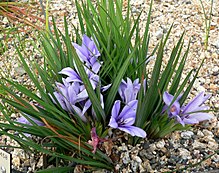


Iris plants are mostly perennial , herbaceous plants , they are only rarely annual (some Sisyrinchium species). The species of the subfamily Nivenioideae lignify.
The basic form of the underground survival organs within the family is a creeping, persistent rhizome , which is usually short. In the tribe Tigrideae onion-like tubers have developed, which are surrounded with dry, brownish coatings (" tunics "). Also in the subgenus Scorpiris , Xiphion and Reticulata of the irises ( Iris ) there are onion-like tubers, which probably originated there independently of each other. The formation of tubers is a fundamental property of the subfamily Crocoideae, but also occurs in some African genera of the sub-shoots Homeriinae and Ferrariinae within the tribe Irideae. In the Crocoideae the tubers have a pronounced central cylinder, form roots from the base of the tubers and usually consist of several internodes . The formation of the tubers differs within the shoots. In the Tribe Watsonieae they arise from an axillary bud at the base of the flower sprout, the sprout on the tuber arises in the tip of the tuber. In contrast, in the Croceae at least some of the tubers arise from the base of the flower sprout, the shoots of the next year arise from buds in the upper nodes of the tuber. The tubers within the tribe Irideae have a diffuse central cylinder, the roots arise from a bud at the tip of the tubers.
leaves
The leaves are usually sword-shaped and morphologically and anatomically the same on the top and bottom (unifacial) and stand on an open leaf sheath. Deviations from this occur with the folded leaves of the Tigridieae and some Crocoideae ( Babiana and most species of Crocosmia ). Dorsi-central stipules with different leaf surfaces have developed several times, especially in the African Homeriinae, a sub-tribus of the tribe Irideae. The subgenus Scorpiris , Xiphium and Reticulata of the iris ( Iris ) have leaves with different tops and bottoms. Dorsiventral leaves occur in the Ixioideae as well as the genera of the crocuses ( Crocus ) and Syringodea . Closed leaf sheaths are found in the whole subfamily Crocoideae, occasionally they also occur in the subfamily Iridoideae.
Inflorescences
The basic form of the inflorescences of the family is the so-called Rhiphidium , a specialized, single-forked Zyme . In the subfamily Iridoideae, these Rhiphidia are either terminally on the main and secondary levels and can be differently designed, arranged in panicles, or they are terminally individually or in groups of a few Rhiphidia. These rhiphidia consist of two large, bract-like flower sheaths, each of which envelops some stemmed flowers that arise from a common starting point. The flowers are lifted out of the vagina one after the other, depending on the number of flowers over a period of up to a week. For the subfamily Nivenioideae, Rhiphidia that are grown in pairs are characteristic. In the genus Isophysis of the monogeneric subfamily Isophysidoideae, the flowers are single, but like the Rhiphidia of the Iridoidae, they are surrounded by two opposite flower sheaths. In the subfamily Crocoideae, the flowers are sessile and surrounded by an outer bract and an inner, two-part cover sheet. Except in the genus Pillansia , the flowers of all Ixioideae are arranged on a straight or slightly curved axis, thus forming a kind of spike. In the genus Pillansia , the flowers are arranged in panicles. In some Crocoideae the spikes are reduced, so that the flowers stand individually or individually at each branch of the flower axis. This form of the inflorescence occurs, for example, in the genera Romulea , Syringodea and the crocuses ( Crocus ).
blossoms

The hermaphrodite flowers of the iris family are very variable in color, size and shape, basic properties are the trinity and the loss of the inner circle of the stamens . Except for the Isophysidoideae, the ovary is subordinate. The flowers are often radial symmetry , exceptions are a large part of the Crocoideae and the genus Diplarrhena from the Iridoideae which are zygomorphic .
The bloom in all Crocoideae and some Nivenioideae ( Nivenia , Witsenia ) Patersonioideae and Iridoideae ( irises ( Iris ), Moraea sect. Tubiflora , Olsynium ) grow together. A corolla tube is typical for all Crocoideae, the flowers of this subfamily are very long-lived with a flowering period of at least two days and have an unbranched venature, which distinguishes them from the short-flowering flowers with branched venature of the Iridoideae and Nivenioideae. The Isophysidoideae also have long-lived flowers.
The stamens are characterized in most genres of tribes Mariceae and Tigridieae by a relatively weak filament from which hardly for supporting the dust bag contributes. These are therefore easily grown together with the upper parts of the pen . In some Irideae and Tigridieae the stamens are fused together. The pollen of the iris family are simply grooved and have a roof-shaped, net-like exine (pollen grain surface). The Crocoideae deviate slightly from this, the exine is finely dotted here and often finely spiked. Pollen without an aperture occurs in the genera Syringodea and the crocuses ( Crocus ). Double-furrowed pollen is common in the Tigridieae. Syncolpate pollen is common in the Iridoideae. Akolpate or anomatreme pollen grains are for some sections and sub-genres of irises ( Iris occupied).

The stylus within the Isophysidoideae and the Nivenioideae consists of relatively short lobes or branches and is pitted on the entire surface. In many Iridoideae the styles have long branches that often protrude beyond the style itself. The edges of these branches are curled up so that they are tubular with only the tip pitted. This structure is further specialized in the Irideae, Mariceae and some genera of the Tigridieae: the tips of the stylus branches are transformed into upright, non-grained appendages in pairs, the grained surface is limited to the lower part. In the Irideae, the appendages are flattened and similar to the corolla, the surface of the stigma is often only a small area in the middle of the appendages. In the Trimezieae and many Tigridieae the stylus processes are thickened, the cicatricial lobe itself often has a second pair of upright processes, which are similar to the processes on the pistil branches, but are smaller. In some genera these stylus structures have regressed, for example in the Eleutherine and Calydorea , where they only form long, thread-like arms, and in the Nemastylis , Alophia and the tiger flowers ( Tigridia ), which usually have slender stylus lobes in pairs.
Fruits and seeds
The compartmentalized ( loculicidal ) capsule fruits have three fruit compartments in which the seeds are in one or two rows. The embryo lies straight in the seed and the endosperm is fleshy or horny. The seeds can have an aril or wings.
Systematics
According to Goldblatt 2008, the Iris family (Iridaceae) now consists of seven subfamilies with 66 genera and a little more than 2,000 species:

Subfamily Aristeoideae: Aristea bakeri

Tribus Croceae: Romulea phenicia
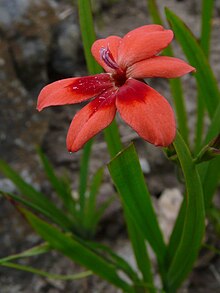
Tribe Freesieae: Freesia laxa

Tribus Gladioleae: Gladiolus illyricus

Tribe Watsonieae: Watsonia pyramidata
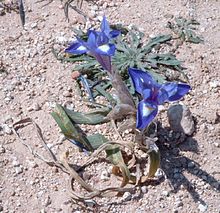
Tribe Irideae: Moraea sisyrinchium

Tribe Tigridieae: Hesperoxiphion peruvianum

Tribus Trimezieae: Neomarica northiana
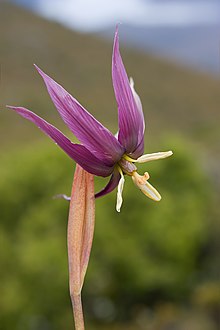
Subfamily Isophysidoideae: flower of Isophysis tasmanica

Subfamily Nivenioideae: Nivenia corymbosa
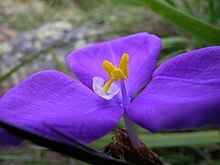
Subfamily Patersonioideae: Flower in detail of Patersonia sericea
|
swell
- Peter Goldblatt & John C. Manning: The Iris Family: Natural History and Classification. , Timber Press, Portland, 2008. ISBN 978-0-88192-897-6 : Google Books.
- Yu-tang Zhao, Henry J. Noltie & Brian F. Mathew: Iridaceae , p. 297 - online with the same text as the printed work , In: Wu Zheng-yi, Peter H. Raven (Ed.): Flora of China , Volume 24 - Flagellariaceae through Marantaceae , Science Press and Missouri Botanical Garden Press, Beijing and St. Louis, 2000. ISBN 0-915279-83-5 (section description, distribution and systematics)
Individual evidence
- ^ Peter Goldblatt: Phylogeny and classification of Iridaceae , In: Annals of the Missouri Botanical Garden , Volume 77, Issue 4, 1990, pp. 607-627.
- ↑ a b Yu-tang Zhao, Henry J. Noltie & Brian F. Mathew: Iridaceae , p. 297 - online with the same text as the printed work , In: Wu Zheng-yi, Peter H. Raven (ed.): Flora of China , Volume 24 - Flagellariaceae through Marantaceae , Science Press and Missouri Botanical Garden Press, Beijing and St. Louis, 2000. ISBN 0-915279-83-5
- ↑ a b c d e Peter Goldblatt & John C. Manning: The Iris Family: Natural History and Classification. , Timber Press, Portland, 2008: Google Books.
- ^ Paul C. Standley and Julian A. Steyermark: Flora of Guatemala , Field Museum of History Botanical Series, Volume 24, Part III, Chicago, USA, 1952.
- ^ Peter Goldblatt & John C. Manning: Phylogeny of the African genera Anomatheca and Freesia (Iridaceae-Ixioideae), and a new genus Xenoscapa. In: Systematic Botany , Volume 20, 1995, pp. 161-178. Abstract.
- ^ Peter Goldblatt: A synoptic review of the African genus Hesperantha (Iridaceae: Crocoideae). In: Annals of the Missouri Botanical Garden , Volume 90, 2003, pp. 390-443.
- ↑ Peter Goldblatt, Aaron Rodriguez, MP Powell, T. Jonathan Davies, John C. Manning, M. van der Bank & Vincent Savolainen: Iridaceae 'Out of Australasia'? Phylogeny, Biogeography, and Divergence Time Based on Plastid DNA Sequences , In: Systematic Botany , Volume 33, Issue 3, 2008, pp. 495-508: Online.
- ↑ a b c d e f g h i j k l m n o p q r s t u v Rafaël Govaerts (ed.): Data sheet at World Checklist of Selected Plant Families of the Board of Trustees of the Royal Botanic Gardens, Kew . Last accessed on October 8, 2016
- ↑ Iridaceae in the Germplasm Resources Information Network (GRIN), USDA , ARS , National Genetic Resources Program. National Germplasm Resources Laboratory, Beltsville, Maryland.
- ↑ Syringodea unifolia in the Red List of South African Plants
- ↑ Species list for Chasmanthe in the Red List of South African Plants
- ↑ Species list for Duthiastrum in the Red List of South African Plants
- ↑ a b Species list for radinosiphon in the Red List of South African Plants
- ↑ Species list on Sparaxis in the Red List of South African Plants
- ↑ Species list for Devia in the Red List of South African Plants
- ↑ Species list for Xenoscapa in the Red List of South African Plants
- ↑ Species list for Melasphaerula in the Red List of South African Plants
- ↑ Species list for Micranthus in the Red List of South African Plants
- ↑ Species list for Pillansia in the Red List of South African Plants
- ↑ Species list for Thereianthus in the Red List of South African Plants
- ↑ Species list for Watsonia in the Red List of South African Plants
- ↑ Walter Erhardt , Erich Götz, Nils Bödeker, Siegmund Seybold: The great zander. Encyclopedia of Plant Names. Volume 2. Types and varieties. Eugen Ulmer, Stuttgart (Hohenheim) 2008, ISBN 978-3-8001-5406-7 .
- ↑ Species list for Klattia in the Red List of South African Plants
- ↑ Species list for Nivenia in the Red List of South African Plants
- ↑ Species list to Witsenia in the Red List of South African Plants

